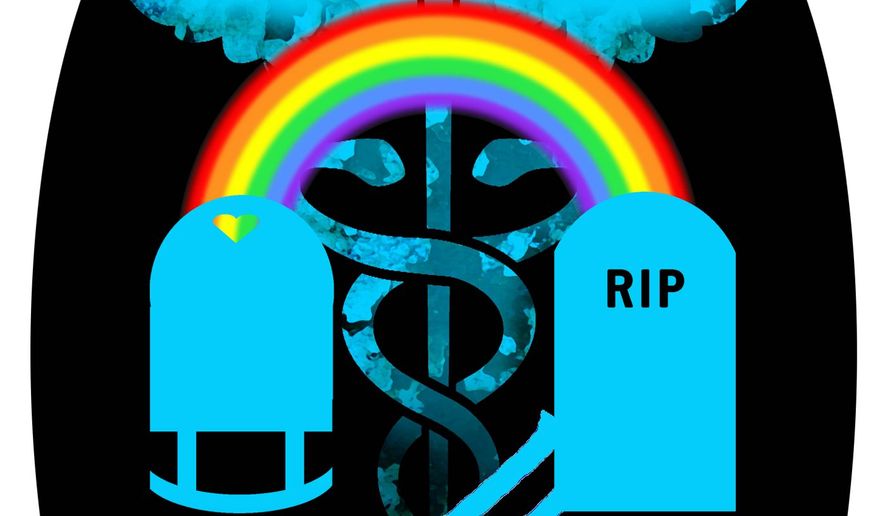OPINION:
Medicare for All epitomizes Democrats’ plethora of promises, despite a paucity of performance. Medicare in its current form is broken and broke. Putting more people and government into it goes beyond dubious to oblivious. Yet, it remains the cornerstone in Democrats’ effort to promise themselves to the presidency.
Part of LBJ’s Great Society, Medicare originally was intended to provide health services for the elderly. It followed Social Security’s social insurance model — payroll tax payments from those currently employed would pre-fund some services (primarily hospital costs, known as Part A) and participant premiums, others (primarily doctor costs, known as Part B).
Ambitious then, it seems quaint now. As with all government programs, Medicare grew in every conceivable way — extending eligibility beyond the aged and greatly expanding benefits.
In 2018, Medicare covered 60 million people, more than one in six Americans. Now Democratic candidates are proposing to bringing in the “other five.” A huge problem with their proposal is highlighted by the Medicare Trustees’ last report: “The financial projections in this report indicate a need for substantial changes to address Medicare’s financial challenges.” Translating that into layman’s terms: Medicare is broke. And it’s getting “broker” … fast.
According to the report, Medicare spent $740.6 billion in 2018 — 60 percent of total federal health care spending. The report estimates that equals 3.7 percent of GDP now, and will reach 6.3 percent in 2043 — and that is with relatively conservative estimates, it could be considerably higher. These scenarios are for current Medicare, not its promised mega expansion.
If that side of the ledger were not bad enough, the other is worse. Funding from outside the government does not begin to keep pace. For Part A, the portion with dedicated revenues (which have been bolstered several times): “In 2018 … expenditures exceeded income by $1.6 billion. The Trustees project deficits in all future years.” For Part B, federal funds already account for “about three-quarters” of its spending.
All this is occurring before health care — and Medicare’s, too — spending is supposed to increase even more. According to the Congressional Budget Office, major health care program spending accounts for 28 percent of noninterest federal spending now; by 2049, it will be 41 percent.
The Democrats’ response to fiscal reality is political fantasy that will make matters worse. They would extend Medicare from its currently unaffordable construction and make it over five-times bigger (the Census Bureau estimates U.S. population at 330 million now).
As Medicare currently proves, the government simply will not say “no” to limiting costs, and Democratic candidates are eagerly falling over themselves to say “yes.” Nor will the government say “yes” to realistic funding options, and Democratic candidates are doing all they can to avoid these, too.
Medicare for All would result in a massively larger beneficiary population, additional covered benefits (since the expanded population would not be elderly) and more government involvement. Of course, this is precisely the recipe, albeit incremental, that has gotten today’s Medicare in its current fiscal fix.
Further, Democratic candidates are marching forward without a dedicated funding source — something today’s Medicare has, but repeatedly outgrew — to offset the enormous new cost. Instead, they only promise that “the rich” will foot the enormous new bill.
It takes a great degree of naivete to believe this — and even greater cynicism — to believe Democratic candidates. It is possible that liberals truly do not care about Medicare for All’s unsustainability. More government is always better, and more reasons to redistribute the private sector’s wealth, better still. That Medicare for All, the justification for doing so, is not plausible, is no reason to not get the dynamic started.
It is also quite possible that the Democratic candidates themselves do not believe it. The problems are too clear for even them to ignore — getting Congress to pass it and the U.S. Supreme Court (remember that the much smaller Obamacare hung in the balance there) to approve it are too unlikely.
Instead, their goal is the promise itself. Simply espousing it puts a candidate in the vanguard of Democrats’ 2020 race to the left. There will be plenty of time later to blame someone else for their fantasy’s failure.
Among these variations of the possible, Medicare for All decidedly remains not one of them. Unsustainable in its current form, and getting less so, Medicare is no model for expansion. Instead, it should be the top model for government reform. But, of course, that would not win any Democratic votes in 2020.
• J.T. Young served in the Office of Management and Budget and at the Treasury Department.




Please read our comment policy before commenting.